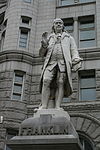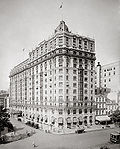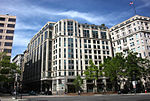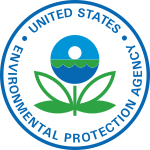Old Post Office (Washington, D.C.)

The Old Post Office, listed on the National Register of Historic Places as the Old Post Office and Clock Tower, is located at 1100 Pennsylvania Avenue, N.W. in Washington, D.C. It is a contributing property to the Pennsylvania Avenue National Historic Site.It succeeded an earlier 1839 edifice–the General Post Office–a building in the Classical Revival style, which was expanded in 1866 on F Street NW. This building later housed the Tariff Commission and several other agencies. The Old Post Office construction was begun in 1892 and completed in 1899. The building is an example of Richardsonian Romanesque, part of the Romanesque Revival architecture of the 19th-century United States. Its bell tower is the third tallest structure in Washington, excluding radio towers. It was used as the city's main General Post Office until 1914 at the beginning of World War I. Afterward, this Pennsylvania Avenue landmark structure functioned primarily as a federal office building. It was nearly torn down during the construction of the surrounding Federal Triangle complex in the 1920s and 1930s. In the 1970s, it was again threatened and nearly demolished to make way for the proposed completion of the enveloping Federal Triangle complex, the proposed buildings to be similar to the Beaux Arts-styled architecture of government offices built in the 1920s and 1930s. Major renovations to The Old Post Office Building were made in 1976 and 1983. The 1983 renovation opened a new chapter in the structure's history and use. Added to the structure were a food court, a retail space, and a roof skylight over the building's central atrium. The building acquired the name of "Old Post Office Pavilion." A glass-walled addition on a former adjacent parking lot was added to the structure in 1991. In 2013, the U.S. General Services Administration (GSA) leased the property for 60 years to a consortium headed by "DJT Holdings LLC", a holding company that Donald Trump owns through a revocable trust. Trump developed the property into a luxury hotel, the Trump International Hotel Washington, D.C., which opened in September 2016 and closed on May 11, 2022, after its sale to CGI Merchant Group. It reopened as the Waldorf Astoria Washington DC on June 1, 2022.The building's 315-foot (96-meter) high clock tower houses the "Bells of Congress," and its observation level offers panoramic views of the city and its surroundings.
Excerpt from the Wikipedia article Old Post Office (Washington, D.C.) (License: CC BY-SA 3.0, Authors, Images).Old Post Office (Washington, D.C.)
Pennsylvania Avenue Northwest, Washington
Geographical coordinates (GPS) Address Phone number Website Nearby Places Show on map
Geographical coordinates (GPS)
| Latitude | Longitude |
|---|---|
| N 38.894166666667 ° | E -77.0275 ° |
Address
Waldorf Astoria Washington DC
Pennsylvania Avenue Northwest 1100
20004 Washington
District of Columbia, United States
Open on Google Maps










